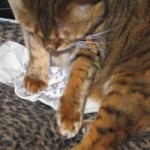Making Sense of Scent
Cats have an acute sense of smell. Scent is one of the ways that they relate and understand their environment. Scents can make or break new relationships. I preach scent exchanges when introducing cats to each other. Scent exchanges can either encourage friendships, or if forced upon cats can lead to violence and stress.
There are some sources on the internet that counsel forced scent exchanges by applying the scent of one cat directly on another when introducing a new cat to the resident cat or when working with inter-cat aggression. I highly recommend not exchanging scents in this fashion. Doing so can stress the cat wearing the other’s scent and result in their hating or fearing each other—they cannot retreat away from the other’s scent. There is a more peaceful way of conducting scent exchanges. Instead of forced scent exchanges, gently pet each cat’s cheek with a different sock or soft towel and then put the scented towels or socks in the other’s confinement area, while the cats remain separated from each other. That way the cats have the choice of checking it out on their own schedule. If the cats don’t feel secure to venture near the scent-laced objects, then they don’t have to. They can wait until the smell dissipates in strength and then investigate it. It’s about choice. And it’s about reducing stress.
Not only does this pertain to cat scents, but also to calming collars and scents that well-meaning people sometimes put on their cats. Cats often find the scents and calming collars annoying or threatening but have no way of escaping them since they are wearing them.


